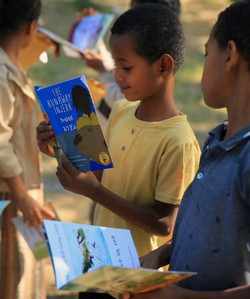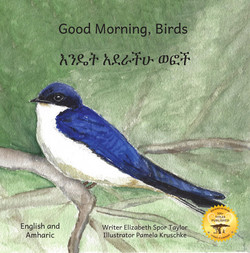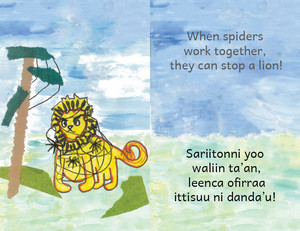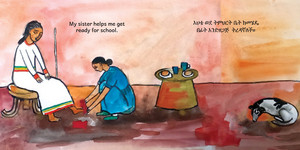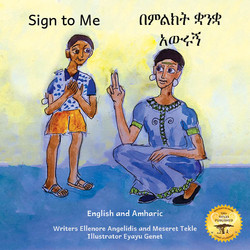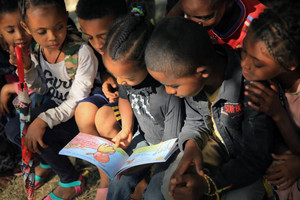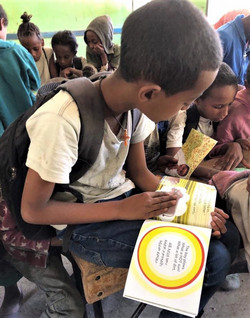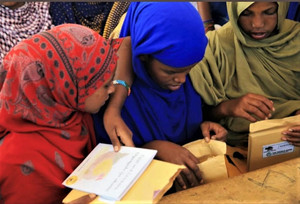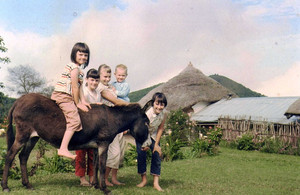Jane Kurtz in conversation with the iRead Foundation
On 21st March 2022, during the IBBY press conference at the Bologna Children’s Book Fair in Italy, it was announced that Jane Kurtz was one of the winners of the 2022 IBBY-iRead Outstanding Reading Promoter Award. Jane was born in the United States and moved to Ethiopia with her parents when she was two years old. Although she returned to the U.S. for college and has lived there since then, her heart remained in Ethiopia. Besides being an established children’s book author and teacher, she is also dedicated to promoting children’s reading and trying to tackle the most fundamental reading problems in Ethiopia, where she learned to read.
Jane’s work began in 1998 when she co-founded Ethiopia Reads after visiting schools in Ethiopia and learning that there was a great need for more books. The first library they opened was in a rented house in Addis Ababa and since then, Ethiopia Reads has set up over 80 libraries across Ethiopia, at least one in every region of the country. In addition to establishing libraries, Ethiopia Reads also provides systematic training for local librarians and other educators, which was not available in Ethiopia before.
In 2016, Jane initiated another project called Ready Set Go Books. This project works on solving the problem of a lack of high-quality reading materials in Ethiopia. This time, she partnered with Ellenore Angelidis and her nonprofit Open Hearts Big Dreams, and took on the role of head of the creative team. So far, Ready Set Go Books has produced more than 100 colorful, easy-to-read and culturally appropriate bilingual books (each one in English and one other local language). Importantly, these books are created in collaboration with local authors, illustrators and translators.
Through these reading promotion models, Ethiopia Reads and Ready Set Go Books, Jane hopes that ultimately more people as well as the government, will be inspired and join the work of raising good and passionate readers.
As the Jury President Sylvia Vardell said in the IBBY press conference, “Jane’s work with literacy addresses the challenges of multiple official languages; lack of books reflecting Ethiopian culture, history, and landscape; obstacles in the translation, publication, and distribution process; and insufficient professional opportunities for educators and librarians. With her vision and collaboration with others, she has planted the seeds of literacy all over Ethiopia.”
In this interview, you will find out more about Jane’s reading promotion work, ideas, childhood and writing career. Download the interview here.
Ready Set Go Books
iRead: Ready Set Go Books has done some very impressive work addressing the fundamental reading problems in Ethiopia. What led you to create this project?
Jane: When I was volunteering for Ethiopia Reads, we were ‘planting’ libraries. One time I was visiting the first library with my brother who is an elementary school teacher. The rooms were full of books in English but most children were lined up at a very small shelf with local language books.
I began to realize that even though we were doing very good work with Ethiopia Reads by establishing libraries for children, we weren't really going to solve reading problems in Ethiopia unless there was more reading material available for children in their own languages.
For decades, Ethiopia Reads has shipped books in English to Ethiopia because there simply aren’t enough Ethiopian books available to fill a library. Ethiopia Reads staff go to bookstores and meet with authors. When they find good books, they buy them. In the early years, they also established an award to encourage more writers to write. But there just weren’t enough books to fill even a small room. It’s really hard when you are stocking a library with English books but the children aren’t reading English as their native language. They can’t get inspired to read and become skillful readers if they don’t have books in local languages. So, after about 15 years of volunteering for Ethiopia Reads, I decided that it was time for me to start a different project.
iRead: What is the Ethiopian publishing industry like?
Jane: In Ethiopia, there are some imported books, some books published by individuals, and curriculum materials published through the government. There isn't a private publishing industry that recruits authors and illustrators, publishes books, handles the publicity and book sales--everything that I'm used to for my books here in the United States. There isn’t really a publishing industry in Ethiopia. Also, most children’s books there only have simple black and white illustrations.
iRead: How does the model for Ready Set Go Books work?
Jane: At the start, I got really excited when I thought I could create some models to tackle this issue of a lack of high-quality reading material in Ethiopia. I hoped when others saw the models, they would get inspired as well. Then I met Ellenore Angelidis who was about to start a nonprofit called Open Hearts Big Dreams that focuses on Ethiopia because she had adopted a daughter from there. We decided that she would be in charge of figuring out the production and distribution process and I would be in charge of creating the content.
As the head of the creative team, I write some of the books myself, recruit and coach writers and illustrators, collaborate with the designer, and guide the Amharic translation. All of our books are bilingual; they each are in English and one Ethiopian local language. We have three different people that work on the Amharic translation and give us feedback.
Once we have created the books, the production team run by Open Hearts Big Dreams makes them available on Amazon and in bookstores, while also raising money to print copies in Ethiopia. I have an important role in the creative part, but the most wonderful thing about this project is that it's a collaboration. There are Ethiopian and American writers, illustrators, designers and translators. And there's a whole team that gets the books out into the hands of the readers.
iRead: How did you find the illustrators and writers for this project?
Jane: It's been tricky because mostly people volunteer their work. I believe in authors and illustrators getting paid, but since this is a nonprofit organization and a nonprofit effort, we ask people to volunteer their work. And because of that, it takes a lot of diplomacy and encouragement.
Finding wonderful illustrations is especially hard because I can do a lot of the writing myself. We have used different groups of people for the illustrations. One group is children. We found that if children have a classroom teacher or an art teacher who knows how to bring out the best of their art, they can create very charming illustrations.
We also have found that there are adults who love to draw but don't have enough outlets for their illustrations. So, they are really happy to know that their illustrations are for children’s books. Near me there are some classes for senior citizens who are learning painting. They paint very well using photographs, so as long as we provide them with photographs of different scenes or children in Ethiopia, they can do very colorful, accurate illustrations.
And then gradually we began to recruit Ethiopian illustrators. There were some Ethiopian artists that traveled with me for an artistic trip to Maji in 2016 when I was first coming up with this idea. In our evening conversations, they gave feedback and brainstormed about the idea of creating books. They were the first contacts, and they gave me other ideas and other connections. It’s amazing that we have so many Ethiopian illustrators who like to donate their work. Some of the painters and fine artists who have their illustrations hanging in the galleries still love the idea of children seeing their work. In Ethiopia, most of the books just have simple black and white illustrations, so the whole concept that a book can be really colorful is appealing for everyone. For a lot of children in Ethiopia, these are the first colorful books that they will get to hold and the very first books that show scenes that are familiar to them.
iRead: You and the team have already produced more than 100 picture books now. How did you come up with so many stories?
Jane: As a writer, I’m always bubbling with ideas, but it’s very hard for me to get my books published here in the United States. There are already so many books on the shelves of bookstores and libraries and for sale, so it’s very competitive. In Ethiopia, there is a wide-open opportunity to explore so many different books because there’s just so much need there.
When I worked with Ethiopia Reads, one thing I learned from talking to the educators in Ethiopia is that many schools really wanted more nonfiction books. They wanted children to really learn about their world, about science, about technology and so on.
There's just so much that can be written for children about science. I was not good at science when I was a child, but now I've turned my backyard into a habitat for birds, bees and butterflies, I really want adults and children to learn more about the power of growing certain plants, how solar energy works, how bees do their job, what birds are around us, and so much more. If you think about all the things in the world that you are curious about, all of those things are good ideas that can be turned into a simple book.
Most of the books we create are easy-to-read books because we are trying to make a bridge between children who can’t read well (or at all) and more complicated literature. I have lots of practice with watching younger children learn how to read and also writing for young readers. After the writing is done, I ask other people to review the manuscripts. It’s always a team effort.
Another source of stories is Ethiopia’s rich proverbs. A lot of those proverbs are actually telling a story. For example, one of the proverbs that you hear often in Ethiopia is “little by little an egg will walk”. With some Ethiopian children’s help, my sister and I turned that proverb into a story.
My grandson, who is Ethiopian-American, worked with me on a book featuring a proverb about a frog wanting to be as big as an elephant. When the frog achieves its goal, it explodes. We had a lot of fun turning that into a story.
A lot of Ethiopian readers have told us that it’s really good that we are making books with these proverbs because in modern times, children aren’t hearing the proverbs as much as before and that we are helping preserve their heritage this way.
Our third source of stories is Ethiopian folk tales. For example, there is a big river in southern Ethiopia and in that area, they have a story about a Nile perch and a crocodile. An Anuak speaker from that part of Ethiopia did a re-telling of the story; we are just getting the illustrations done for the book featuring this folk tale.
iRead: For the nonfiction books, how do you make sure the information is accurate?
Jane: I’m an author of nonfiction books published in the U.S. as well, and the process isn’t any different. As an author or an editor, I use reputable sources, compare information between sources, consult with experts, ask our educator and local volunteers to review text and illustrations, and keep an eye open for any writing or illustration that seems one-sided or might be inaccurate. We are creating books with very few words on most of the pages, so that makes the job easier than with something long and involved.
iRead: How long does it take for you to create one Ready Set Go Book?
Jane: There is an educator who has taught many children who are reading in English as a second language, and she reminded me recently that she started writing a Ready Set Go Book three or four years ago. She tried her concept a number of ways before coming up with an excellent draft. Then it was illustrated by an Ethiopian friend of hers living in the U.S. Then our main Ethiopian reviewer thought it needed major changes, so it’s still not finished.
A lot of how long books take depends on the illustrators. When I'm writing a book, sometimes I get stuck and have to think about it for a long time. But let’s say if an idea comes to me and it flows very well, I might be able to write it in a week. Then I ask my team to review it. That will take a few more weeks.So, we might be able to finish the writing in a month, all polished and edited.
Then comes the work of the illustration. This takes much longer. Let me give you an example. In Ethiopia, a branch of the Nile River is called Abay, or sometimes called the Blue Nile by outsiders. An Ethiopian friend of mine had suggested this idea for a book. A grandmother who lives across a river from me said she wanted a project for her grandchildren to work on during COVID, so I gave them some photographs of the Nile River and asked them to create the illustrations. Perhaps it took 4-6 months of the kids working with their grandmother, who’s a talented artist. Then I got the illustrations and wrote the text, which led me to ask for some more images—a papyrus boat, a crocodile, and some hippopotamuses. It has taken us at least six months to finish the illustrations. After that, there’s still the design work to be done.
The translation is a long process as well. An author and educator in Ethiopia does the first translation. That draft is reviewed by a woman in Ethiopia who works at an international school in Addis Ababa. She reads lots of books to children and understands what we're trying to do with making the language playful. And then our final reviewer is an Ethiopian cardiologist who lives in Minneapolis here in the United States. Sometimes he says, “no, this won't work.” And because he had his medical training here in the United States, he can explain in English what the problem is. And then all of that has to be fixed. So sometimes one book can be created very quickly and sometimes it takes a long time. In general, we have to count on it being about at least 6 months.
iRead: What’s the percentage of Ethiopian authors and illustrators you have?
Jane: The translation is done 100% by Ethiopians. At this point, I would say about 1/3 of the illustrators are Ethiopian. We’ve started doing some books that feature children with special needs such as blind children and deaf children and children in wheelchairs. We try especially hard with those books to use Ethiopian illustrators who know the situation there—unless we have excellent photographs that can provide a resource.
If COVID stays calm, I really would love to go to Ethiopia again, and my highest priority is to do a workshop for illustrators. The art scene in Ethiopia is amazing these days. Using that talent to make books appealing for children is an exciting possibility.
iRead: How about the writers?
Jane: We have some Ethiopian writers. Language is always tricky. Because all of these books are bilingual, the text has to work in both languages. We don't have a lot of Ethiopian writers who want to do their writing in English as first draft. We've tried having someone to write in Amharic first and translate it into English. It's just really tricky, overall. There’s a lot of language exchange back and forth and coaching. All of the writers and editors—myself included—have connections to Ethiopia that guide our efforts. Dr. Woubeshet, who reviews all of the titles in English and Amharic, commented to me that with my childhood in Ethiopia, I know enough to know what I don’t know.
Here’s another important fact of the Ready Set Go Books: More of them are read in an Ethiopian language than in English. People don’t realize how much translation is an art that uses excellent writing skills, and all of the books are available in at least three Ethiopian languages—with more languages added all the time. Open Hearts Big Dreams is being approached by more and more diaspora communities who want the books available in their own Ethiopian languages. They are forming teams to figure out translation and review, and they are also providing content to make sure some of the books reflect the geography and culture and customs of their part of Ethiopia. So in a way, 100% of the books are written by Ethiopians, because they are creating the versions that most of the readers will encounter.
iRead: When creating these picture books, what are some of the criteria you use to assess whether a book is good enough to be published?
Jane: The question about how to know a good book is one that has been raised when I’ve done talks in Ethiopia, too. Here in the U.S., we have a powerful community of librarians and other educators and reviewers and journalists and others who write reviews about books and help shape opinions about them. The reading public has its own ways of speaking up about what they consider a good book. That’s not the case in every country. World Bank has a manual (Read@Home) widely available that has some guidelines to start with.
Since speaking at the IBBY-USBBY Regional Conference in Nashville this spring, I’ve been reading A Bridge of Children’s Books about how Jella Lepman gathered books at the start of the International Youth library. Of course, she had to start with whatever she had. After World War II, children’s literature grew enormously, and I was there almost from the start. Little Golden Books, meant to get books into homes in the U.S. The Dick and Jane readers, meant to replace the old Aesop’s fables (in primers for children learning to read) with real-life scenes. Dr. Seuss, who was asked to produce something more playful than what by then seemed stodgy and with scenes that reflected a small slice of American life. “Whole language” as a trend in education. Data-driven reading instruction. And so on. All along, I’ve been a reader and—for much of that time—a writer and a teacher. I’ve been edited; I’ve been an editor. I’ve been reviewed; I’ve been a reviewer. I’ve taught writing at the elementary, secondary, university, and now masters level. As a faculty member of the Vermont College of Fine Arts MFA in Children’s and YA literature, I’ve read thousands of essays analyzing children’s books.
That’s all to say that I’ve gathered a lot of knowledge and opinions that I bring to this project. At heart, though, I’m an artist. When people put their music and paintings and pottery and creative writing and so on out into the world, they are always experimenting. I’m not a writer who produces educational materials, but one who believes artists and young people should rub elbows and learn from each other’s efforts and wonder. As the head of the creative team, I use my own aesthetic judgement and—along with the head Ethiopian reviewer—have the final say.
iRead: How do you train and coach the other artists and authors?
Jane: When it comes to illustration, my own picture books with major publishing companies are under the guidance of an art director, so this is my first experience putting words and pictures together. I just keep book illustration principles in mind: one example is to let the illustrations do some of the work, leaving room for readers to infer and pick up clues and figure things out for themselves. Another example is to be sure important details don’t get lost in the “gutter”—the middle of the book. We aim for colorful, culturally accurate art where young readers can see themselves and see parts of Ethiopia that are unfamiliar to them. As I mentioned, I have decades of teaching writing to draw on when I coach writers. This kind of easy-reader book is a new concept in Ethiopia. I focus on basic things such as how to craft a compelling beginning, middle, and end; how to leave room for readers to infer and predict; how to use words in interesting and playful ways; how to choose English words that will be relatively easy to decode and sentence syntax that isn’t complicated.
iRead: After you’ve created the content, how did you do the work of printing, distribution, promotion and so on?
Jane: You put your finger on a very big part of the project. The founder of Open Hearts Big Dreams, Ellenore Angelidis, is in charge of the project after the creative team is done. She’s very energetic and determined to figure out how to get the books out and into the hands of readers: she explores leads that come her way; she has opportunities for interviews on radio programs and podcasts; she also puts the word out on social media. People mostly hear about our books by word of mouth—from my speaking, from Ellenore’s speaking, from supporters within the Ethiopian diaspora, from the world-wide community that cares about Ethiopia or about global literacy. The books are sold on platforms such as Amazon. People from the U.S. and other countries in the world can buy both the e-editions and paperback copies that are printed on demand. These tend to be expensive because the books aren’t printed until somebody orders the book. The ones printed in Ethiopia are less expensive because the money for printing a large number of copies is raised upfront. When we sell the books here in the United States, all the profits from selling the books go right back into the project because it's a nonprofit.
Open Hearts Big Dreams is also getting orders from educational projects, mostly NGOs in Ethiopia that want to buy the books and that will pay for the printing. We have a teammate in Addis Ababa—an author, educator and entrepreneur—who works with Open Hearts Big Dreams to oversee the printing and stores and delivers copies of the printed copies.
So far, we have more than 100 titles published and we've printed about 250,000 books in Ethiopia, but our goal is to print at least a million books in the future. We know providing children with appealing reading material in their own languages can make a huge difference. However, I don't think having a nonprofit doing all the publishing work is the answer. Ultimately, what I’m trying to do with this work is to fill in the gap for now and to provide good models. And then I'm hoping that there will eventually be a publishing industry. I think this is a problem all around the world because it takes capital to develop a publishing company. It takes enough individual families and schools and libraries that buy copies of the book to make all that printing work.
I'm hoping if we can show that it really works, and if we can show that the demand is there, and if we can help build the demand for books, then in the future, publishers will see that this can be a good business proposition. Ultimately children need so many books and at many different levels. We are just doing pretty simple books to help children get skillful at reading, but then they are going to need more books to read.
iRead: It was all NGOs that bought the Ready Set Go Books?
Jane: Mostly NGOs, including Ethiopia Reads who has been ‘planting’ and supporting libraries for a couple of decades now, as well as doing work around advocacy and family literacy. Last year, Ethiopia Reads got a grant from the World Bank to print 45,000 copies of some titles and distribute the books to 15,000 families who were living in Displaced Persons Camps because of the armed conflict in Ethiopia this year.
An Ethiopian photographer took pictures of the families when the Ethiopia Reads staff was distributing the books. He said that compared to distribution of food and medicine that he has documented, the book distribution was the most touching to him because when children smile, the parents have hope. That meant so much to me to hear.
Again, although Ethiopia Reads and Open Hearts Big Dreams are small organizations, both of them are creating great models to show what can be done. The Ministry of Education in Ethiopia had a member that went along and saw the distribution in the Displaced Persons Camp and said that it hadn't occurred to them that this was something they could do. So, we continue to communicate with the Ministry of Education—including an annual reading summit organized by Ethiopia Reads—and hope that our efforts will inspire more official efforts. When Sakil Malik was head of what was then called the International Reading Organization, he taught me the importance of having advocacy as part of all global reading projects.
Someone once told me, Ethiopia is a graveyard of dead projects. I thought I don’t want my projects to be in that graveyard. So, I knew I would have to be very stubborn and that any project would take a lot of persistence. I knew the change would not be coming quickly.
iRead: Does the government have the money to buy the books and distribute them at the moment?
Jane: Hopefully they will. It's all about budgeting. Government entities can be difficult to work with, but the Ethiopia Reads Ethiopian staff has helped by having conversations with regional educational bureaus. The Ministry of Education has also gone through many of the titles and approved them, which is helpful whenever the books are distributed in actual classrooms. Even though we're doing the Ready Set Go Book project mostly with private funding, we aren't doing it outside of the purview of the Ministry of Education. A big part of the effort is to have the Ministry of Education see what we're doing. Ideally the Ministry will start to fund libraries and library trainings and buy books. I don't think right now they have that kind of budget, but the hope is that they will at some point in the future.
iRead: How much does it cost to print one book in Ethiopia?
Jane: Everything depends on paper prices, which fluctuate. If a printing ends up around $2 a book, which is likely, that is still expensive for a lot of Ethiopian families and that’s why the books are mostly being distributed free through educational projects. I don’t doubt that eventually there will also be books sold because in Addis Ababa, there are many middle-class Ethiopian families that want to have books for their children, but everything takes time and know-how to develop systems.
Ethiopia Reads
iRead: Could you tell us a bit about Ethiopia Reads?
Jane: I grew up in Ethiopia and came back to live in the United States for college. After my parents left Ethiopia when I was 25, I hadn't gone back for 20 years until I was invited to speak in three international schools in Addis Ababa.
To give a bit of background, Ethiopia had gone through big political changes during that period of 20 years. For example, the number of primary schools grew from 3,196 in 1974/75 to 7,900 in 1985/86. Primary school enrollment increased from about 957,300 in 1974/75 to nearly 2,450,000 in 1985/86.Financial help for meeting Ethiopia’s educational challenges over those decades came from many different countries including the U.S., the European Economic Community, and the Soviet Union. By the time of my visit, many urban neighborhoods and rural communities had schools—but classrooms tended to be overcrowded and many had no books at all.
In conversations during my author visit, I began to learn about what had happened in the last 20 years. I was surprised that it seemed there was a real interest among some of my contacts in providing more books—perhaps via libraries—for children in Ethiopia. Of course, I was eager to help if there was anything one person could do. Almost immediately, I began to raise money and worked with an Ethiopian-American librarian to co-found a nonprofit to experiment with whether it was possible for a community of readers to help grow a reading culture in a place with limited educational resources. That's how Ethiopia Reads got started.
When I read your interview with Zohreh Ghaeni from 2020, I thought about how different reading projects can be. An initiative that comes out of a university or perhaps out of a foundation or has a government funding stream (such as USAID) will be one kind of effort. Ours was more a people-to-people kind of effort. How can individuals put their knowledge and resources together to make a difference? If we had ended up with one or two successful models of a reading room or a library for children, I would have been thrilled.
The first library we opened was just in a rented house in Addis Ababa. Then my Ethiopian-American co-founder began to explore whether we could partner with government schools. If they would give us a room and provide a person to run the library, then we would ship books in English and furnish the space with furniture. Forward-thinking school directors can be found everywhere, and Addis Ababa was no exception.
We quickly saw that the people running the school libraries would need training, since there was no formal librarian education program available in Ethiopia. I recruited librarians and other educators from my circle of contacts (as an author and presenter) in the U.S. and Europe, and I organized a volunteer teacher-to-teacher sharing, where we would learn from Ethiopian educators about their realities and needs while also sharing what the volunteers had found effective in their libraries and classrooms.
That initial effort has grown into a team of volunteers here in the United States that has gone to Ethiopia multiple times, developed training modules, and worked with the Ethiopia Reads staff, so that the staff are able to go out and provide some training and support to those running the libraries. At the first reading summit organized by Ethiopia Reads, one of those librarians spoke about how she not only was able to increase her skills, but also felt a sense of pride in her role through the training and through organized conversations with the other librarians to exchange ideas about what was working well. Representatives from the Ministry of Education at the summit were so impressed by everything they heard that they invited Ethiopia Reads to submit a proposal for a 300- library pilot project, which has been accepted but not yet funded.
Perhaps the easiest way for me to describe the challenges Ethiopia Reads has always faced is to share this link describing the situation 5-6 years ago. There are many, many issues that the Ethiopian government needs to solve. The education system is huge, with over 30,000 primary schools and over 23 million students. In 2018, a study showed only 6% of students reading at grade and 25% not reading a single word. But how are children supposed to learn to read without good reading materials? Ethiopia Reads has worked steadily to develop school library models and is currently engaging more directly with the part of Ethiopian society that has direct influence—parents. Parents everywhere want to help their children, but many Ethiopian parents have not had the direct experience of knowledge about how reading supports their children’s education, and what they can do about it.
iRead: What was your role at Ethiopia Reads?
Jane: My main jobs were to raise money, recruit and guide fellow board members, be in conversation about strategic directions, and provide training and support. I was lucky in those days because I was publishing children's books, and it was a time in the United States that people wanted to have authors come and speak. So, I was able to speak at a lot of schools and conferences and I always shared the story of Ethiopia Reads. I found that families, teachers and librarians all wanted to donate money. We also got some small grants from foundations, but mostly Ethiopia Reads has been funded through individuals.
One of the most time-consuming tasks was recruiting board members and to getting them informed and excited about fundraising and about ways to support the Ethiopian staff’s effort in Ethiopia. It’s also very important for me to learn continuously, so that when we traveled to Ethiopia, I was able to offer what the staff actually wanted and needed.
To be clear, of course a country like Ethiopia needs well-organized, well-funded projects that have resources to carefully take one step at a time and measure impact. My efforts remind me more of what Jella Lepman did that eventually became the organization IBBY. I’m an artist—and artists are in some ways the least influential members of society, often struggling just to pay their own bills—but they have a way of using their artistic voices—their writing or singing or painting or other expressions—to speak out about things that matter to them. All of my efforts can be seen in that light. Fortunately, along the way I’ve found many individuals who believe they can make a difference even with small amounts of time and money.
iRead: Why did you decide to step off the board?
Jane: A nonprofit organization doesn’t belong to any one person, and I stepped off the Ethiopia Reads board because I had been doing it for 15 years. If any organization is going to thrive, there needs to be new leadership. So, I thought it was time. The operations of Ethiopia Reads in Ethiopia have always been run by local Ethiopians; the board is there to raise money and provide support and oversight.
I was also excited to try the new idea that became Ready Set Go Books. I love what Ethiopia Reads has done and is still doing, but I don’t think we are going to solve the reading problems if we don’t have more colorful and appealing books in local languages.
iRead: Have the projects of Ethiopia Reads and Ready Set Go Books made any impact on the national policy level?
Jane: The Ministry of Education has been very impressed with both what Ready Set Go Books and Ethiopia Reads are doing. I think it's just a challenge of having a country that has so many educational needs. There’s a big expansion at the higher education level and all that has to be funded. The next priority is probably high school. I don’t think the Ministry of Education is dismissive of younger children’s needs. It’s just a lower priority. Ethiopia Reads staff has had meetings with the Ministry of Education for many years and there’s been a lot of encouragement. But whether there will actually be funding, I don’t know.
Childhood and Writing Career
iRead: Can you tell us a little bit about your childhood?
Jane: I was two years old when my parents went to Ethiopia, so I don't have any memories of my life in the United States before that. Before my parents moved to live in a rural part of Ethiopia called Maji, they spent two years in Addis Ababa learning Amharic. But I don’t have a lot of memories living in the big city, either.
Where I grew up was very remote. There was one Ethiopian Airlines flight in a week. It didn't land up at the top of the mountain where we lived. It landed down in the savannah where it's flat, and then a mule or a Jeep would bring the mail and the other supplies up the mountain. The area was beautiful. My brother, sisters and I all loved living there.
My mom home-schooled us for the first three grades. We spent a lot of our time just playing and running up and down the mountain. My dad put a mill at the waterfall to grind grain and we would run with him to check the mill every day. It was just a wonderful and magical place to grow up.
When I was seven, we visited the United States for a year and again for another year when I was thirteen. Those were hard years for me because I hadn’t had the same childhood experiences as everyone else although I spoke English. They didn’t know how to ask me good questions about Ethiopia. That's one of the reasons why I love it that Ready Set Go Books are also available in America, Canada and Europe. There are a lot of Ethiopian children all over the world, and I know from when I was a child that their classmates and teachers probably don't know very much about Ethiopia.
Then I came back to the United States for college. I still went back to Ethiopia a lot until my parents also left when I was 25.
iRead: Did you feel you were different when you were a kid?
Jane: We definitely knew we were different in Maji. The only people that spoke English were my family, a nurse and a teacher. So language differences were very obvious. Skin color differences were very obvious, too. Little girls would come and play with us when they were young. But when girls got to be about 6 years old, they had work to do in their houses. The school that was right outside my house was attended by almost all boys. So, from the age of 6, I was cut off from playing with Ethiopian children.
When I was in fourth grade, I went to boarding school in Addis Ababa. I had Ethiopian classmates, but they were more from families that spoke English at home and their parents wanted them to speak English at school. So, I didn’t have the chance to learn Amharic.
iRead: When you were in Ethiopia, did you have a lot of books to read?
Jane: In the rural part of Ethiopia where I grew up, there was a school that my dad was in charge of helping administer and keep operating smoothly. The curriculum in that school was all in the language of Amharic. My parents knew that ultimately, we would return to the United States and go to college there, so we needed to learn to read and write in English.
They packed books to take with them and those were the books that I had available when I was a child. I didn't have a lot of books, but the ones that I had were very precious. And luckily, my mom, even though she hadn't finished her college education when they went to Ethiopia, was a passionate reader. I’ve definitely seen the power of families to encourage reading—especially if one of the family members loves books. That's what happened in my family. My mom just loved to read books, and so she was able to teach all of us how to read and to inspire all of us to become really good readers.
When I speak at conferences or in schools, I always emphasize the importance of parents as role models for children. The main reason I wanted to read was because I saw my mom reading. That's the gift that my mother gave to me and that I passed along to my children. And now my son and my Ethiopian daughter-in-law are passing a love of reading to their children.
Of course, that's difficult if you have low adult literacy. Then I hope that children will see a teacher reading or they will have a library available to them. Children need to be introduced to books somewhere and realize that people don't read because they are supposed to read. They read because they have a passion for reading.
iRead: Why did you choose Psychology as your major in college?
Jane: I loved books and I thought I was going to be an English major. But we were reading things like Chaucer and 17th century poets at the time. I was just a teenager and that kind of literature didn’t seem interesting to me.
I was curious about why people act the way they do. And I wanted to learn more about my fellow human beings and more about myself. So that's why I became a Psychology major.
iRead: And then you started teaching?
Jane: I didn't have a teaching degree, but I taught in an alternative school that had been started by some university parents where I was living in southern Illinois. It was a great time to explore some of the ideas I had about children and reading and writing. I was just in my 20s and had lots of experimental ideas about how to get kids excited about reading and writing. And I got to try them out. I also became the director of that school for two years.
iRead: What were some of the ways you used to get help kids read and write?
When I speak at conferences or in schools, I always emphasize the importance of parents as role models for children. The main reason I wanted to read was because I saw my mom reading. That's the gift that my mother gave to me and that I passed along to my children. And now my son and my Ethiopian daughter-in-law are passing a love of reading to their children.
Of course, that's difficult if you have low adult literacy. Then I hope that children will see a teacher reading or they will have a library available to them. Children need to be introduced to books somewhere and realize that people don't read because they are supposed to read. They read because they have a passion for reading.
iRead: Why did you choose Psychology as your major in college?
Jane: I loved books and I thought I was going to be an English major. But we were reading things like Chaucer and 17th century poets at the time. I was just a teenager and that kind of literature didn’t seem interesting to me.
I was curious about why people act the way they do. And I wanted to learn more about my fellow human beings and more about myself. So that's why I became a Psychology major.
iRead: And then you started teaching?
Jane: I didn't have a teaching degree, but I taught in an alternative school that had been started by some university parents where I was living in southern Illinois. It was a great time to explore some of the ideas I had about children and reading and writing. I was just in my 20s and had lots of experimental ideas about how to get kids excited about reading and writing. And I got to try them out. I also became the director of that school for two years.
iRead: What were some of the ways you used to get help kids read and write?
Jane: When I taught third and fourth graders, I did lots of reading aloud. I took my students to the local library and encouraged them to create plays and simple videos and art connections of all kinds with whatever they discovered that they loved to read. Also, I provided phonics support for students who needed it. In those early years, I was doing writing with children aged 6-12. I encouraged children to observe closely and use the five senses to describe their experiences and observations. I provided them with lots of examples and feedback and opportunities to have conversations with their peers. At that time, educators were asking, “If we want children to be good writers, shouldn’t we be mimicking the process of authors—people who love to write and choose to write constantly?” I spent a lot of time thinking about what I was doing in my own writing life and how to share the practice with my students.
With my own children and grandchildren, I filled their lives with books and spent a lot of time listening to their interests so I could find new books to introduce them to. We played games around phonics, keeping it fun and engaging. Also—of course—I modeled. They always saw both my husband and me choosing to read. I read out loud to them even after they were skilled readers, so we had lots of warm shared experiences of books and stories.
iRead: How did you get your first opportunity to get published as a writer?
Jane: When I had my own children, I was going to the library and coming home with armloads of books every few weeks, discovering all kinds of new books, loving the sounds of the words and the joy of sharing those words. I really fell in love with children’s books and set a goal that I wanted to publish a children’s book. I started to submit my work, and it took me 10 years before I got my first book published.
iRead: Before that you just kept on trying and trying?
Jane: Trying and failing. Lots and lots of failure, and lots and lots of writing and revising and studying the craft of writing and submitting stories to editors. Sometimes an editor would be encouraging, sometimes my book would even get to a committee, and it would look like it was going to be published. Here in the United States, it's a very competitive process. I used to say that I had never tried to do anything that competitive before. But I kept trying because I loved books so much.
iRead: How old were you when your first book was published?
Jane: I think I was in my 30s when I first got a book published, but I was in my 40s before my publishing career really got some momentum and took off. There was a long time of failing before I started to succeed. Now I’m thrilled to be part of a team that provides coaching, modelling, encouragement, conversation, and feedback in order to encourage other artistic people around the globe to do the hard work of creating compelling books.
Thank you Jane for a fascinating insight into your work!


